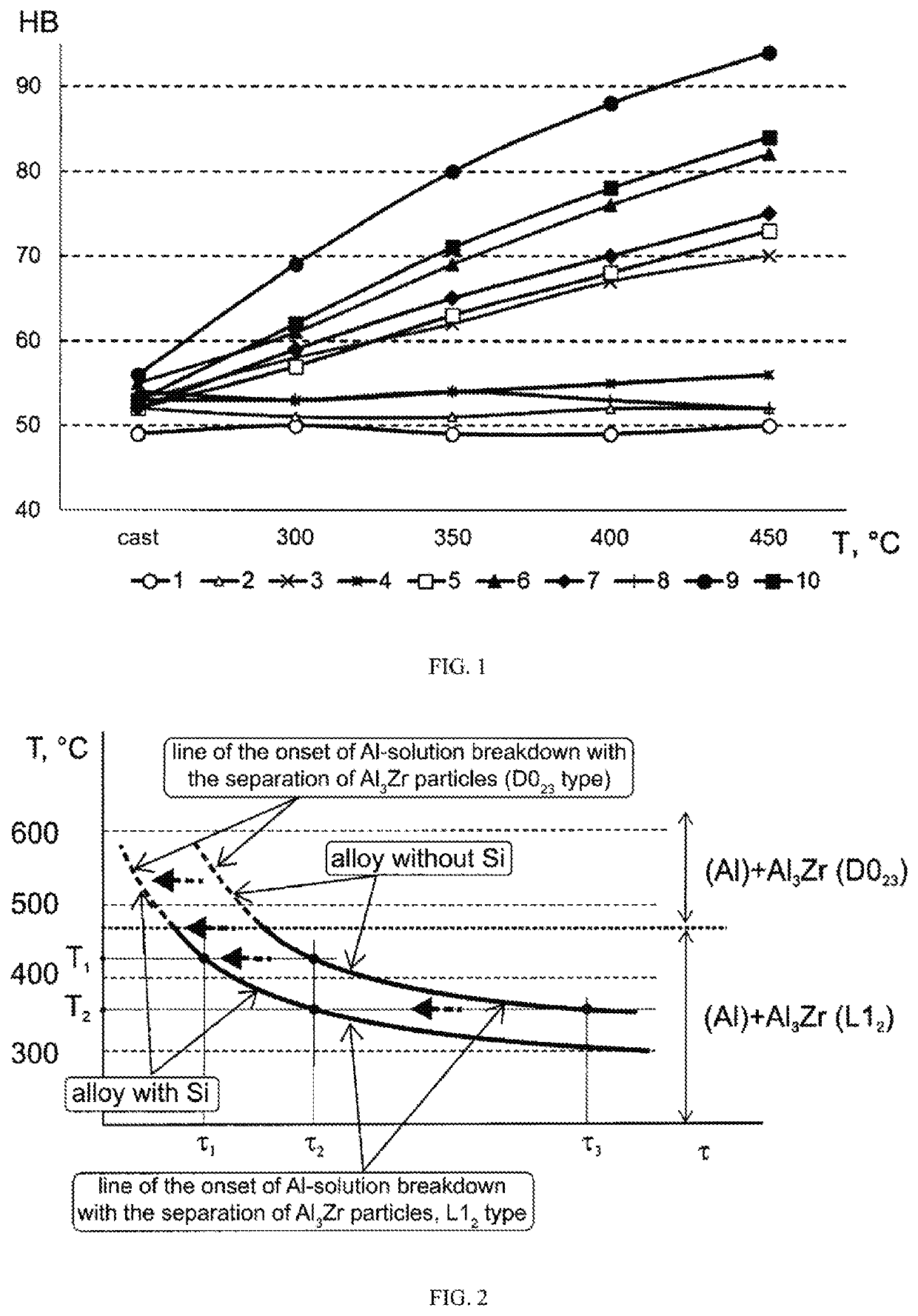Aluminum-Based Alloy
a technology of aluminum-based alloys and alloys, applied in the field of aluminum-based materials, can solve the problems of substantial deterioration of product yield upon deformation, reduce performance, etc., and achieve high mechanical properties, high physical and mechanical properties, and high performance in deformation processing.
- Summary
- Abstract
- Description
- Claims
- Application Information
AI Technical Summary
Benefits of technology
Problems solved by technology
Method used
Image
Examples
example 1
[0040]Ten experimental alloys were prepared in a laboratory setting as flat ingots. The chemical composition is given in Table 1. The as-cast alloys had the structure of an aluminum solution with iron- and cerium-containing eutectic phases in the background. No primary crystals of D023 type were found. Silicon influence on strengthening of the experimental alloys was evaluated by changes in hardness (HB) upon step-wise annealing starting with 300° C. to 450° C., with a step of 50° C. and a duration of up to 3 h at each step. The results of the hardness measurement are shown in FIG. 2
TABLE 1Chemical Composition of the Experimental AlloysAlloyChemical Composition, wt. %No.ZrFeMnCrScCeSiZr + 2*Sc100.20.510.5300.520020.190.190.510.5100.5100.1930.20.20.50.5300.520.140.2400.210.50.5200.510.14050.210.210.50.520.110.5200.4360.20.210.510.520.10.530.140.4070.30.210.510.520.050.5300.40800.210.510.520.10.5300.290.60.210.510.520.10.530.100.8100.60.210.510.520.10.5300.8
[0041]An analysis of the ob...
example 2
[0045]Six experimental alloy compositions were prepared in a laboratory setting as 0.8 mm thick rolled sheets. The chemical composition is given in Table 2.
TABLE 2Chemical Composition of the Experimental AlloysAlloyChemical Composition, wt. %No.ZrFeMnCrScCeMgSiNote110.140.170.430.180.12—3.90.14120.140.170.400.170.11—5.10.14Cracks130.140.180.410.200.10—6.10.14Cracks140.150.190.430.180.120.213.80.14150.140.180.420.170.110.205.10.14160.140.170.410.190.100.206.10.14Cracks
[0046]Under deformation processing, alloys No. 12, 13 and 16 had cracks at the edges upon rolling. A comparison of alloys No. 12 and 15, having comparably similar concentrations of the doping elements, apart from cerium content, shows that alloy No. 15 produced no cracks upon rolling, which is explained by the presence of the eutectic phase promoting a more homogeneous deformation and, as a result, the absence of cracks upon sheet rolling. However, with a higher magnesium concentration, even the presence of the eutectic...
example 3
[0049]In a laboratory setting, alloy No. 15 (Table 2) and the alloy with a chemical composition given in Table 4 were used to prepare samples in the form of ingots and powder for four cooling rates, primarily to evaluate the sizes of structural components of eutectic phases and the presence / absence of primary crystals.
TABLE 4Chemical Composition of the Experimental AlloysAlloyChemical Composition, wt. %No.ZrFeMnCrScCeMgSi170.50.140.400.170.115.03.10.14
Cooling Rate,Alloy No.K / sec1517Less than 1Average size ofMore than 10−Fe-containing phases, μmPresence of D023+−10Average size of3 −Fe-containing phases, μmPresence of D023None−100Average size of1.5−Fe-containing phases, μmPresence of D023None−100,000Average size of−Less than 1Fe-containing phases, μmPresence of D023NoneNone
PUM
| Property | Measurement | Unit |
|---|---|---|
| Length | aaaaa | aaaaa |
| Fraction | aaaaa | aaaaa |
| Pressure | aaaaa | aaaaa |
Abstract
Description
Claims
Application Information
 Login to View More
Login to View More - R&D
- Intellectual Property
- Life Sciences
- Materials
- Tech Scout
- Unparalleled Data Quality
- Higher Quality Content
- 60% Fewer Hallucinations
Browse by: Latest US Patents, China's latest patents, Technical Efficacy Thesaurus, Application Domain, Technology Topic, Popular Technical Reports.
© 2025 PatSnap. All rights reserved.Legal|Privacy policy|Modern Slavery Act Transparency Statement|Sitemap|About US| Contact US: help@patsnap.com

